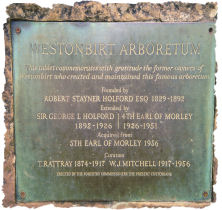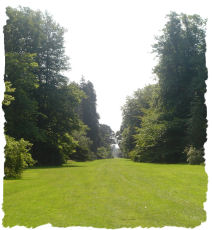
Estate Arboretums
![]() he aristocratic impulse for tree collecting resulted in the formation of various major estate arboretums during the nineteenth century and was of considerable importance in the development of the arboretum. The larger estates had extensive resources and manpower, they provided an important forum where landscape gardeners and gardeners could train and conduct experiments.
he aristocratic impulse for tree collecting resulted in the formation of various major estate arboretums during the nineteenth century and was of considerable importance in the development of the arboretum. The larger estates had extensive resources and manpower, they provided an important forum where landscape gardeners and gardeners could train and conduct experiments.
During the course of the century major estate arboretums and pinetums were established on many estates including Whiteknights in Berkshire, Elvaston in Derbyshire, Bicton in Devonshire and Westonbirt in Gloucestershire which now, of course, forms the basis of the national arboretum.
Commemorative stone in the corner of Holford Road and Mitchell Drive. Westonbirt Arboretum.
( Click here to enlarge)

With the expansion of the railway network during the 1840's the estate arboretums became public attractions and were visited by hundreds of thousands of gardeners and amateur gardeners. The gardens, arboretum and Pinetum at Chatsworth in Derbyshire, the seat of the Dukes of Devonshire, were designed by the head gardener, Joseph Paxton who was enabled to develop original gardening ideas and practices here that he later incorporated into public parks and the Crystal Palace Gardens.
The arboretum and Pinetum at Chatsworth served as an important model and stimulus for the development of other private and public arboretums. This was partly through the thousands of visitors who streamed to Chatsworth, through Paxton’s work and publications, and also through the work of other landscape gardeners who trained there, especially Edward Kemp, John Scott and Edward Milner.
